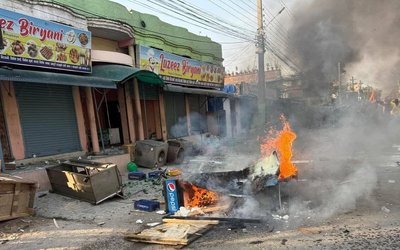More on News






Minister for Health and Population Khagraj Adhikari was handed over recommendations for necessary action required to improve health services in Nepal. This was a result of regional level consultations with stakeholders in various districts of Nepal. The consultation led by National MCH Alliance with the support of World Vision, an INGO identified issues related to maternal and child health that still needs attention with 500 days remaining to meet the MDGs.
Receiving the recommendations, minister Adhikari said, “it is good to see civil society’s involvement and support to the government to improve the health of mothers and children in Nepal and we are positive about the recommendations handed over to us.”
Pushkar Khati, Campaign Specialist for World Vision International Nepal says, “though Nepal has made good progress in the area of child health and maternal health and is on track to achieve its MDGs with remarkable reduction in national childhood mortality i.e. the infant mortality rate (IMR) having declined from 108 to 46 and the under-five child mortality rate (U5MR) from 162 to 54 per 1,000 live births between 1990 and 2011, variation by both ecological and development regions still exist with IMR and U5MR being highest in the mountains (at 73 and 87 per 1,000 live births respectively). Likewise national maternal mortality ratio has dramatically declined from 850 maternal deaths per 100,000 live births in 1990 to 229 per 100,000 live births in 2009. However, it is highest among Muslims (318), Terai/Madhesi (307) and Dalits (273) compared with the Brahman/Chhetris (182) and Newars (108). Therefore there is a need to address the social and economic disparities with regards to access of essential health care services. Intentional intervention to reach the unreached needs to be better integrated into the national programs and policies to bring changes that constrain women, the poor, and the excluded from using various services. ”
Nepal Government has been implementing different development programs with the support of civil society to achieve its targets for MDGs like strategies to raise awareness on pregnancy complications, birth preparedness by improving transport, free birthing services in health facilities and expanding services at selected public health facilities to reduce the risk of maternal death. Likewise immunization for children and nutrition was a priority to save the lives of under-fives.
“However the challenge for the government remains in bridging the social and geographical disparities in maternal and child health. So our recommendation is a call from civil society to think beyond the MDG if we want an equitable and sustainable development,” informs Khati.
World Vision International Nepal has been implementing a nationwide campaign with specific focus in Kailali and Doti Districts; working with local government and civil society for maternal, newborn and child health. Tools like Community Voice and Action which provides opportunities for participation and negotiation and equips community with the knowledge of existing government services have been applied to improve health systems. The campaign is now led by the community with community volunteers working on raising awareness on simple solutions to reduce preventable deaths of children under five.
The National Maternal and Child Health Alliance (National MCH Alliance) was formed as an autonomous and neutral national network after a national level consultation held on 2-3 September, 2013 among non- government organizations working on maternal and child health sector in Nepal. The alliance works to build capacity and network among civil society organizations working on maternal and child health sector for strengthened advocacy on increased access to health services for mother and children. 13 non government organizations (from 13 districts) working for maternal and child health are members including World Vision.
According to a press release issued by World Vision Nepal, World Vision is a Christian relief, development and advocacy organization dedicated to working with children, families and communities to overcome poverty and injustice. Motivated by our Christian faith, World Vision is dedicated to working with the world’s most vulnerable people. World Vision serves all people regardless of religion, race, ethnicity or gender.
Child Health Now is World Vision’s five-year global advocacy campaign aiming to see an end to the more than six million deaths of children under five each year. It is calling on governments and supporters to play their part in a global movement that ensures children access to nutritious food, clean water, and life-saving health services. World Vision International Nepal had formally launched the campaign in June 2012. In the countdown to the MDGs, we are working with external partners for maternal, newborn and child health to highlight the need for more action to help more children survive the age of five.






